Search Result
Results for "
RAR-gamma
" in MedChemExpress (MCE) Product Catalog:
6
Isotope-Labeled Compounds
| Cat. No. |
Product Name |
Target |
Research Areas |
Chemical Structure |
-
- HY-107437
-
|
|
RAR/RXR
|
Metabolic Disease
|
|
CD2665 is an orally active and selective RAR-β,γ antagonist, with Kd values of 306 nM, 110 nM for RAR-β and RAR-γ, repectively .
|
-
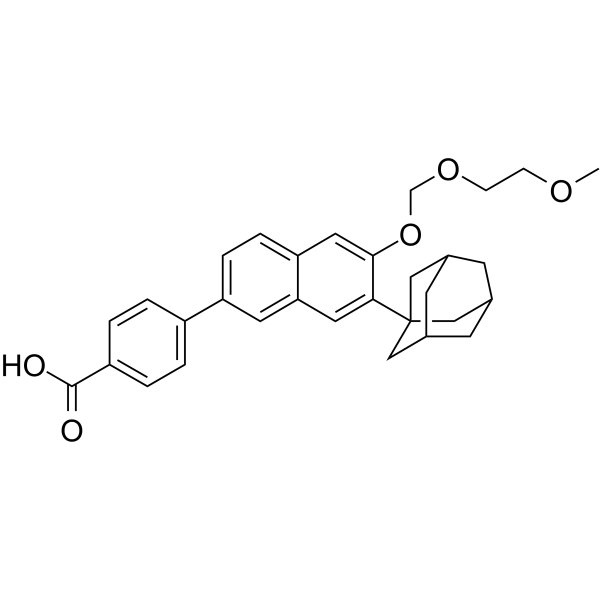
-
- HY-108530
-
|
|
RAR/RXR
|
Cancer
|
|
MM11253 is a potent and selective RARγ antagonist with an IC50 of 44 nM. MM11253 has lower inhibition of RARα, RARβ and RXRα. MM11253 blocks the growth inhibitory effects of RARγ-selective agonists .
|
-
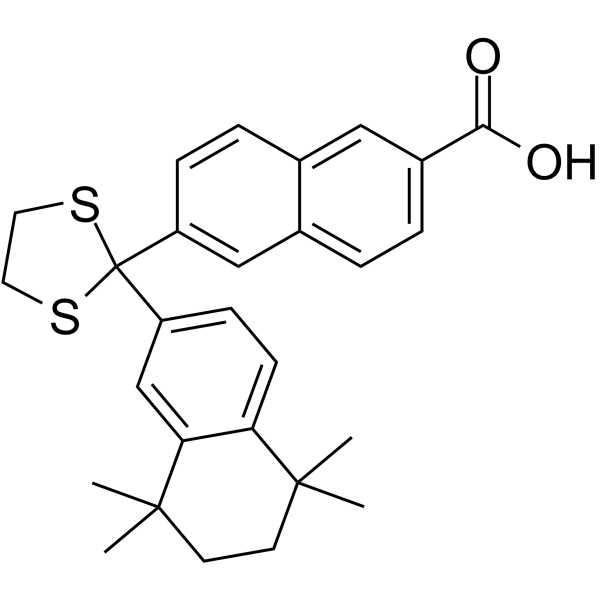
-
- HY-14799
-
|
R 667; Ro 3300074
|
RAR/RXR
Autophagy
|
Others
|
|
Palovarotene is a nuclear retinoic acid receptor γ (RAR-γ) agonist.
|
-

-
- HY-100532
-
-
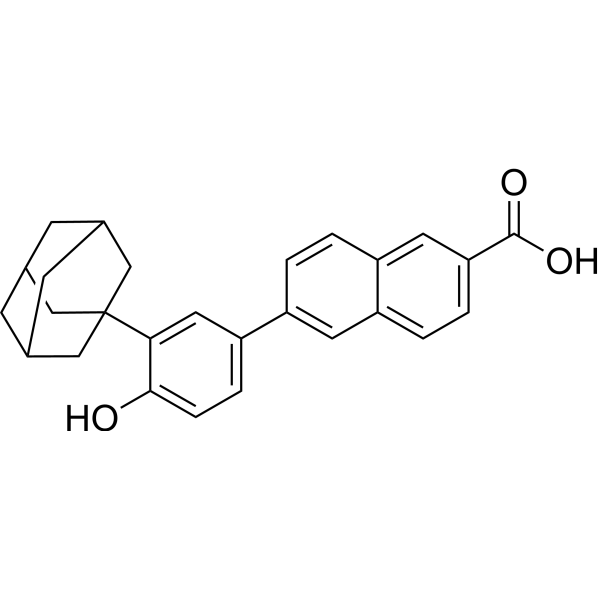
-
- HY-105689
-
|
|
RAR/RXR
|
Others
|
|
AGN 192870 is a RAR neutral antagonist with Kds of 147, 33, and 42 nM for RARα, RARβ, and RARγ, respectively. AGN 192870 shows IC50s of 87 and 32 nM for RARαand RARγ, respectively. AGN 192870 shows RARβ partial agonism . AGN 192870 is a click chemistry reagent, it contains an Alkyne group and can undergo copper-catalyzed azide-alkyne cycloaddition (CuAAc) with molecules containing Azide groups.
|
-
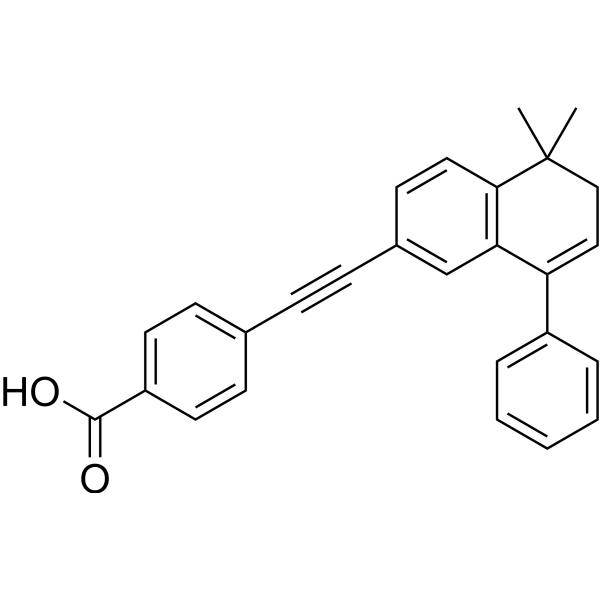
-
- HY-100256
-
|
CD5789
|
RAR/RXR
Autophagy
|
Inflammation/Immunology
|
|
Trifarotene (CD5789) is a potent and selective RARγ agonist. Trifarotene (CD5789) shows ∼65-fold and ∼16-fold selectivitiy for the RARγ (EC50=7.7 nM) over RARα (EC50=500 nM) and RARβ (EC50=125 nM), respectively .
|
-

-
- HY-16683
-
|
|
RAR/RXR
Autophagy
|
Cancer
|
|
AGN 205728 is a potent and selective RARγ antagonist with Ki/IC95 values of 3 nM/ 0.6 nM; no inhibiton on RARα and RARβ.
|
-

-
- HY-14652
-
-
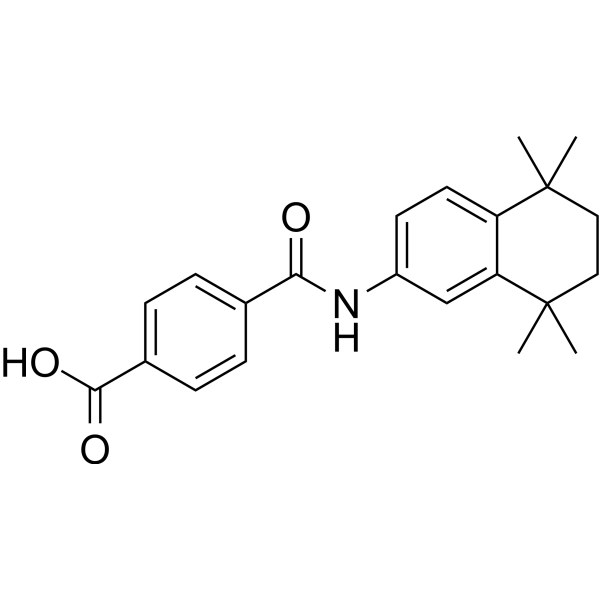
-
- HY-16682
-
|
|
RAR/RXR
Autophagy
|
Cancer
|
|
AGN 196996 is a potent and selective RARα antagonist with Ki value of 2 nM; little binding affinity for RARβ(Ki=1087 nM) and RARγ(Ki=8523 nM).
|
-
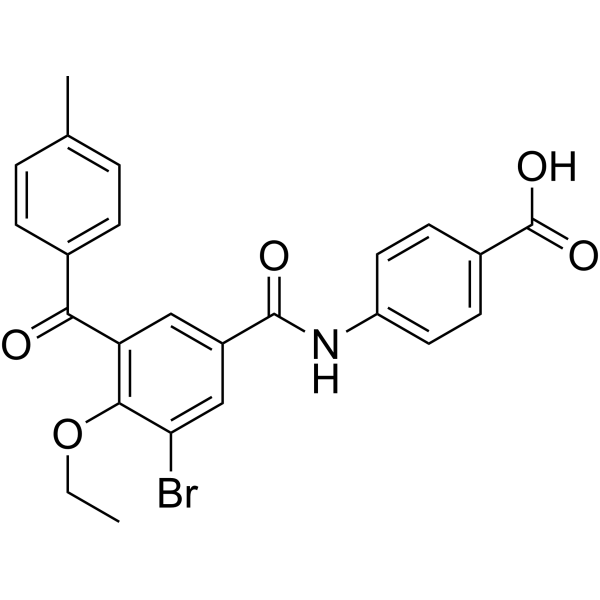
-
- HY-107765
-
-
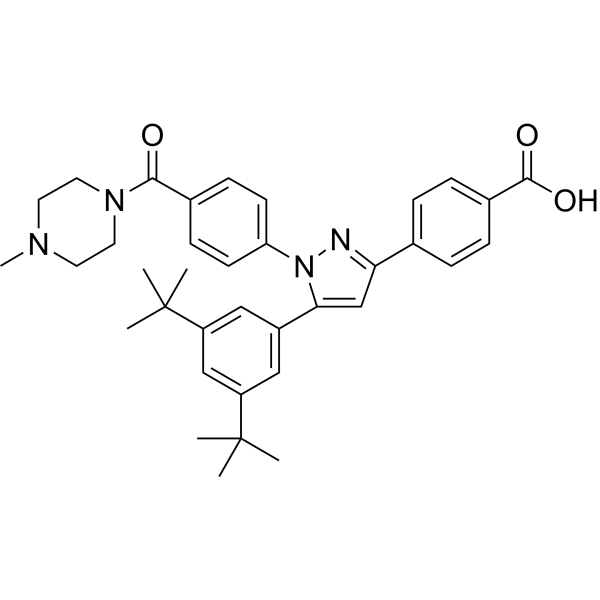
-
- HY-119518
-
|
BMS-209641
|
RAR/RXR
|
Cancer
|
|
BMS641 (BMS-209641) is a selective RARβ agonist. BMS641 has a higher affinity for RARβ (Kd, 2.5 nM) that is 100 times higher than that for RARα (Kd, 225 nM) or RARγ (Kd, 223 nM) .
|
-
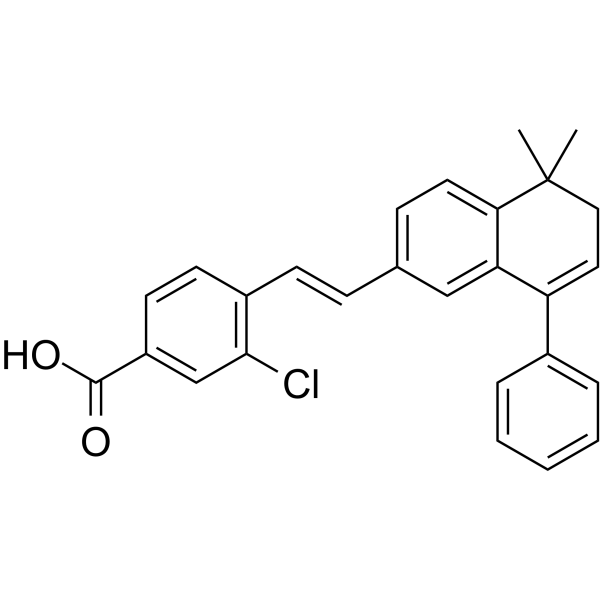
-
- HY-107436
-
LE135
1 Publications Verification
|
RAR/RXR
TRP Channel
|
Neurological Disease
Cancer
|
|
LE135 is a potent RAR antagonist that binds selectively to RARα (Ki of 1.4 μM) and RARβ (Ki of 220 nM), and has a higher affinity to RARβ. LE135 is highly selective over RARγ, RXRα, RXRβ and RXRγ. LE135 is also a potent TRPV1 and TRPA1 receptors activator with EC50s of 2.5 μM and 20 μM, respectively .
|
-

-
- HY-16685
-
|
|
RAR/RXR
Autophagy
|
Cancer
|
|
AGN 205327 is a potent synthetic RARs agonist with EC50 of 3766/734/32 nM for RARα/β/γ respectively; no inhibition on RXR.
|
-
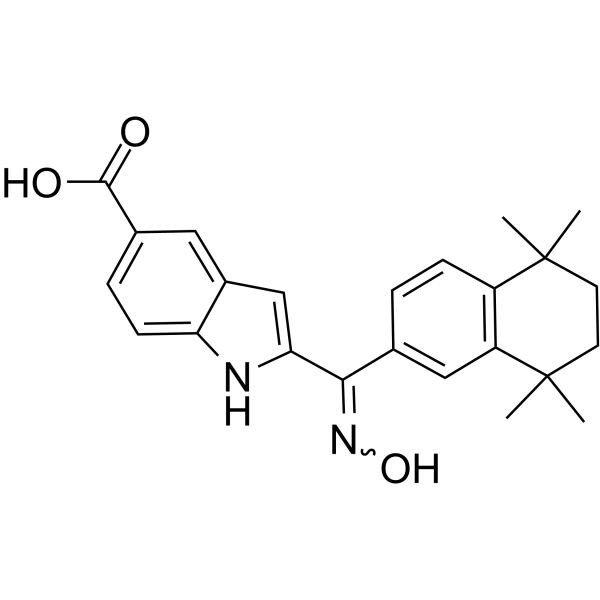
-
- HY-U00449S
-
|
|
Isotope-Labeled Compounds
RAR/RXR
Autophagy
|
Cancer
|
|
AGN 193109-d7 is the deuterium labeled AGN 193109. AGN 193109 is a retinoid analog, and acts as a specific and highly effective antagonist of retinoic acid receptors (RARs), with Kds of 2 nM, 2 nM, and 3 nM for RARα, RARβ, and RARγ, respectively.
|
-

-
- HY-15682
-
TTNPB
3 Publications Verification
Ro 13-7410; Arotinoid acid; AGN191183
|
RAR/RXR
Autophagy
Apoptosis
|
Cancer
|
|
TTNPB is a highly potent RAR agonist. Competitive binding assays using human RARs yield IC50s of α=5.1 nM, β= 4.5 nM, and γ=9.3 nM, respectively.
|
-
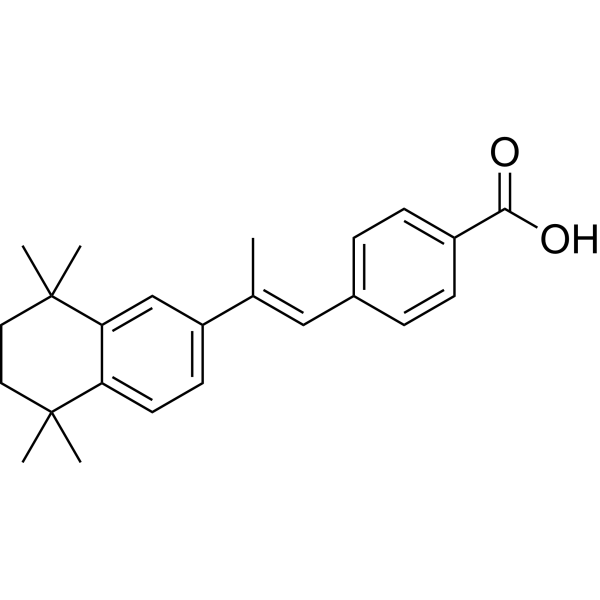
-
- HY-108528
-
-
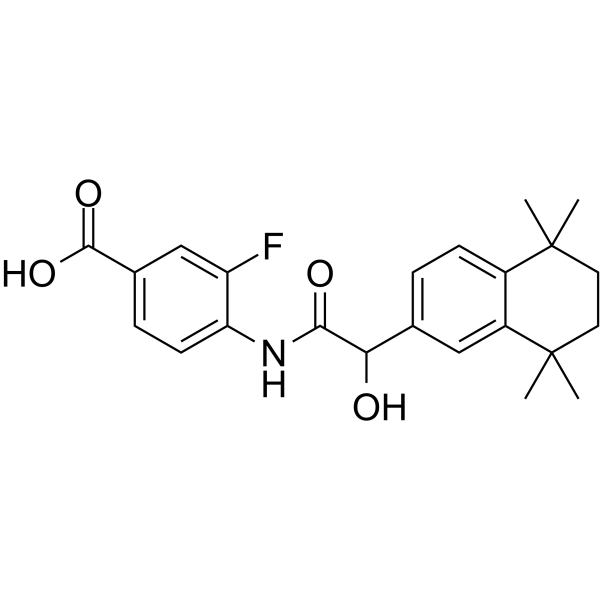
-
- HY-100608
-
BMS453
1 Publications Verification
BMS-189453
|
|
|
|
BMS453 (BMS-189453), a synthetic retinoid, is a RARβ agonist and a RARα/RARγ antagonist. BMS453 inhibits breast cell growth predominantly through the induction of active TGFβ .
|
-

-
- HY-U00449
-
|
|
RAR/RXR
Autophagy
|
Cancer
|
|
AGN 193109 is a retinoid analog, and acts as a specific and highly effective antagonist of retinoic acid receptors (RARs), with Kds of 2 nM, 2 nM, and 3 nM for RARα, RARβ, and RARγ, respectively. AGN 193109 is a click chemistry reagent, it contains an Alkyne group and can undergo copper-catalyzed azide-alkyne cycloaddition (CuAAc) with molecules containing Azide groups.
|
-

-
- HY-100532S
-
-

-
- HY-16681
-
|
VTP-194310
|
RAR/RXR
Autophagy
|
Cancer
|
|
AGN 194310 (VTP-194310) is a high affinity, potent and selective retinioic acid receptors (RARs) pan-antagonist with Kd values of 3 nM, 2 nM, 5 nM for RARα, RARβ, RARγ, respectively . AGN 194310 is a click chemistry reagent, it contains an Alkyne group and can undergo copper-catalyzed azide-alkyne cycloaddition (CuAAc) with molecules containing Azide groups.
|
-
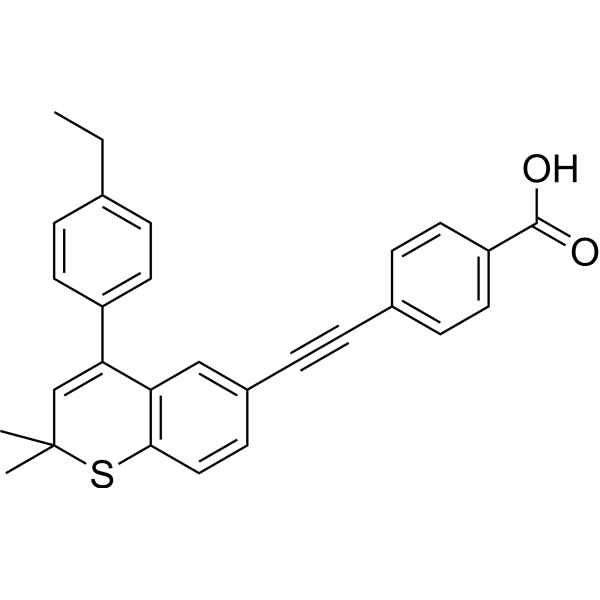
-
- HY-B0091
-
|
CD271
|
RAR/RXR
Autophagy
Apoptosis
|
Neurological Disease
Inflammation/Immunology
Cancer
|
|
Adapalene (CD271), a third-generation synthetic retinoid, is widely used for the research of acne. Adapalene is a potent RAR agonist, with AC50s of 2.3 nM, 9.3 nM, and 22 nM for RARβ, RARγ, RARα, respectively. Adapalene also inhibits the enzymatic activity of GOT1 in a non-competitive manner. Adapalene exhibits anti-tumor activity .
|
-
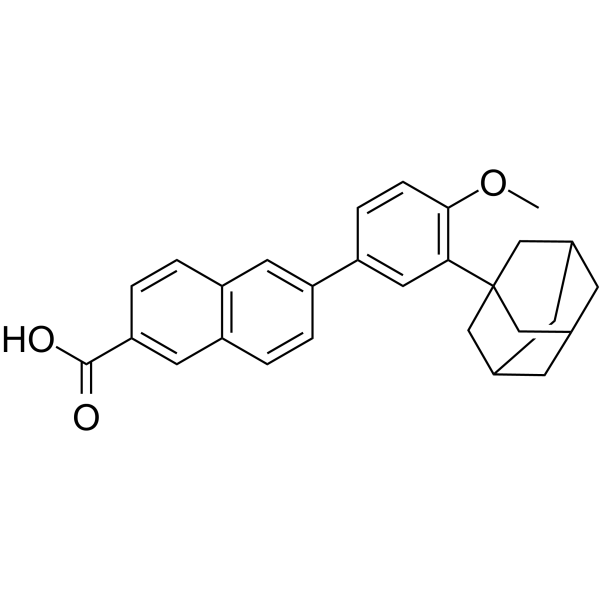
-
- HY-B0091A
-
|
CD 271 sodium salt
|
RAR/RXR
Autophagy
Apoptosis
|
Neurological Disease
Inflammation/Immunology
Cancer
|
|
Adapalene (CD271) sodium salt, a third-generation synthetic retinoid, is widely used for the research of acne. Adapalene sodium salt is a potent RAR agonist, with AC50s of 2.3 nM, 9.3 nM, and 22 nM for RARβ, RARγ, RARα, respectively. Adapalene sodium salt also inhibits the enzymatic activity of GOT1 in a non-competitive manner. Adapalene sodium salt exhibits anti-tumor activity .
|
-
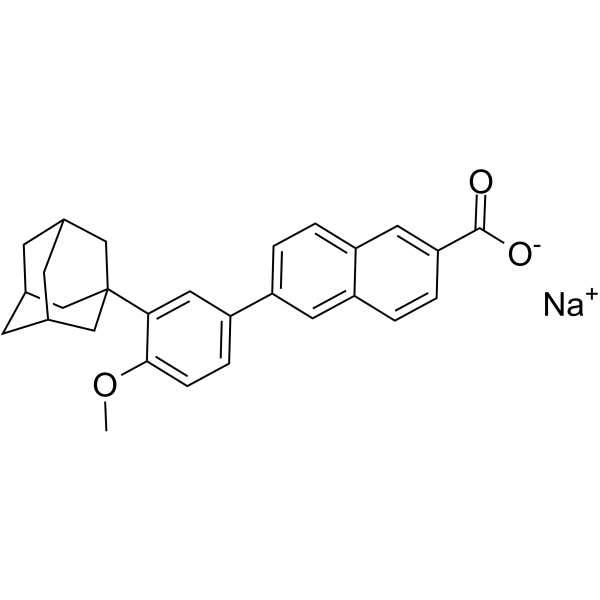
-
- HY-16684
-
|
IRX-5183; VTP-195183; NRX-195183
|
RAR/RXR
Autophagy
|
Cancer
|
|
AGN-195183 (IRX-5183) is a potent and selective agonist of RARα (Kd=3 nM) with improved binding selectivity relative to AGN 193836. AGN-195183 has no activity on RARβ/γ.
|
-
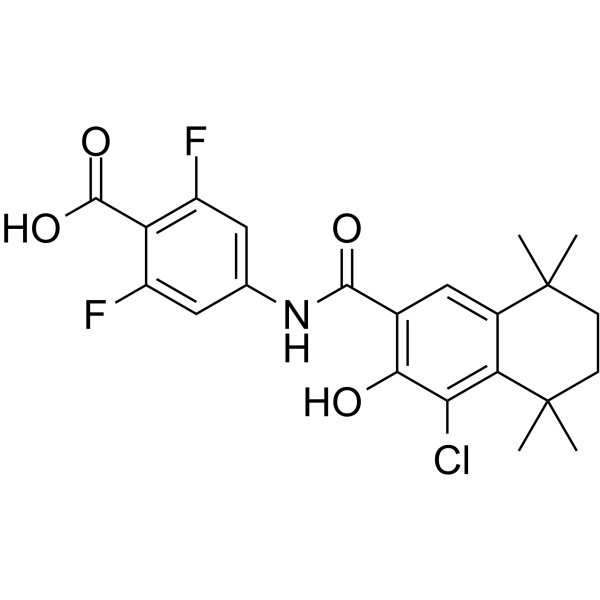
-
- HY-B0091S
-
|
|
RAR/RXR
Autophagy
Apoptosis
|
Neurological Disease
Inflammation/Immunology
Cancer
|
|
Adapalene-d3 is the deuterium labeled Adapalene. Adapalene (CD271), a third-generation synthetic retinoid, is widely used for the research of acne. Adapalene is a potent RAR agonist, with AC50s of 2.3 nM, 9.3 nM, and 22 nM for RARβ, RARγ, RARα, respectively. Adapalene also inhibits the enzymatic activity of GOT1 in a non-competitive manner. Adapalene exhibits anti-tumor activity[1][2][3].
|
-
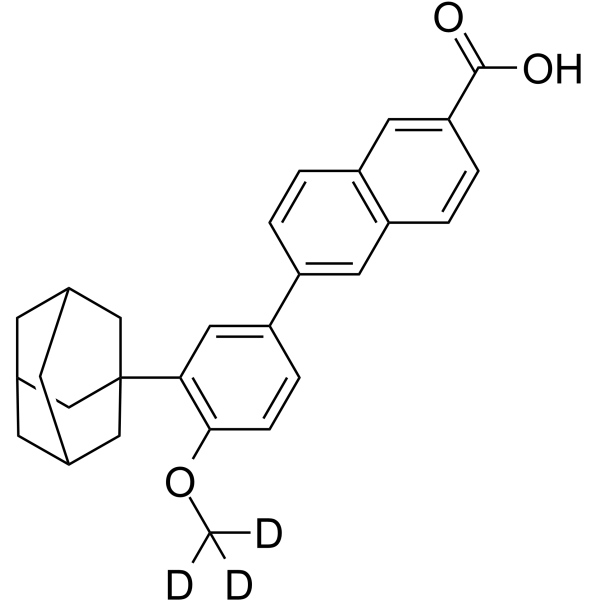
-
- HY-B0091R
-
|
CD271 (Standard)
|
RAR/RXR
Autophagy
Apoptosis
|
Neurological Disease
Inflammation/Immunology
Cancer
|
|
Adapalene (Standard) is the analytical standard of Adapalene. This product is intended for research and analytical applications. Adapalene (CD271), a third-generation synthetic retinoid, is widely used for the research of acne. Adapalene is a potent RAR agonist, with AC50s of 2.3 nM, 9.3 nM, and 22 nM for RARβ, RARγ, RARα, respectively. Adapalene also inhibits the enzymatic activity of GOT1 in a non-competitive manner. Adapalene exhibits anti-tumor activity .
|
-
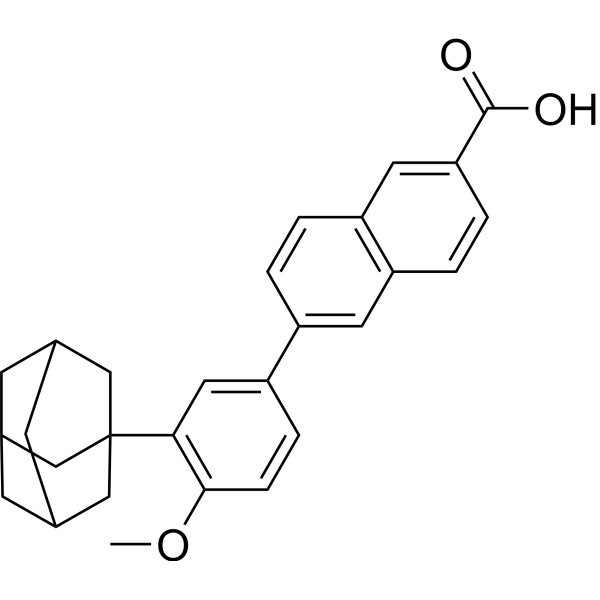
-
- HY-14649
-
Retinoic acid
Maximum Cited Publications
50 Publications Verification
Vitamin A acid; all-trans-Retinoic acid; ATRA
|
Organoid
RAR/RXR
PPAR
Endogenous Metabolite
Autophagy
|
Cancer
|
|
Retinoic acid is a metabolite of vitamin A that plays important roles in cell growth, differentiation, and organogenesis. Retinoic acid is a natural agonist of RAR nuclear receptors, with IC50s of 14 nM for RARα/β/γ. Retinoic acid bind to PPARβ/δ with Kd of 17 nM. Retinoic acid acts as an inhibitor of transcription factor Nrf2 through activation of retinoic acid receptor alpha.
|
-

-
- HY-14649R
-
|
Vitamin A acid (Standard); all-trans-Retinoic acid (Standard); ATRA (Standard)
|
RAR/RXR
PPAR
Endogenous Metabolite
Autophagy
|
Cancer
|
|
Retinoic acid (Standard) is the analytical standard of Retinoic acid. This product is intended for research and analytical applications. Retinoic acid is a metabolite of vitamin A that plays important roles in cell growth, differentiation, and organogenesis. Retinoic acid is a natural agonist of RAR nuclear receptors, with IC50s of 14 nM for RARα/β/γ. Retinoic acid bind to PPARβ/δ with Kd of 17 nM. Retinoic acid acts as an inhibitor of transcription factor Nrf2 through activation of retinoic acid receptor alpha.
|
-
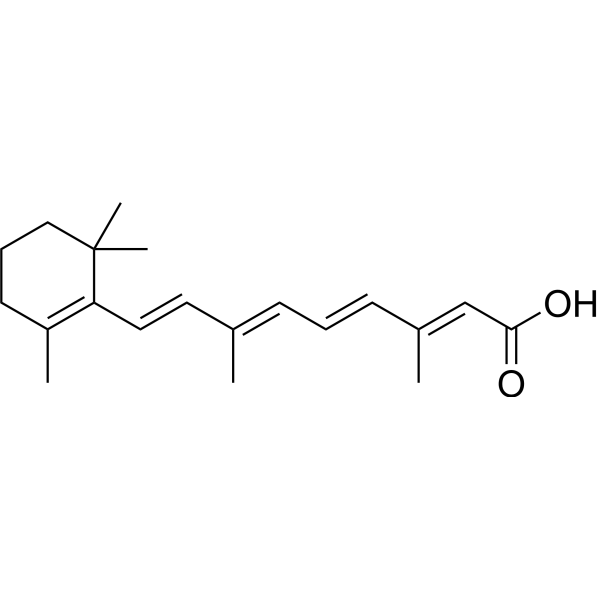
-
- HY-14649S2
-
|
|
RAR/RXR
PPAR
Endogenous Metabolite
Autophagy
|
Cancer
|
|
11-cis-Retinoic Acid-d5 is the deuterium labeled Retinoic acid. Retinoic acid is a metabolite of vitamin A that plays important roles in cell growth, differentiation, and organogenesis. Retinoic acid is a natural agonist of RAR nuclear receptors, with IC50s of 14 nM for RARα/β/γ. Retinoic acid bind to PPARβ/δ with Kd of 17 nM. Retinoic acid acts as an inhibitor of transcription factor Nrf2 through activation of retinoic acid receptor alpha[1][2].
|
-
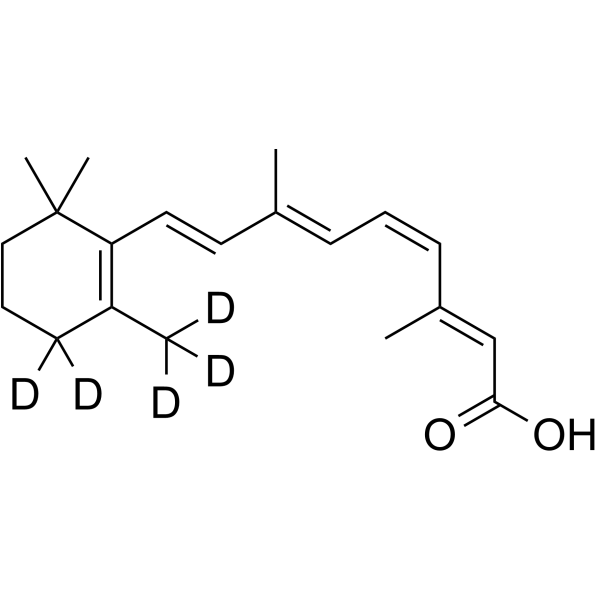
-
- HY-14649S4
-
|
Vitamin A acid-d5; all-trans-Retinoic acid-d5; ATRA-d5
|
Isotope-Labeled Compounds
RAR/RXR
PPAR
|
Cancer
|
|
Retinoic acid-d5 is the the deuterium labeled Retinoic acid (HY-14649). Retinoic acid is a metabolite of vitamin A that plays important roles in cell growth, differentiation, and organogenesis. Retinoic acid is a natural agonist of RAR nuclear receptors, with IC50s of 14 nM for RARα/β/γ. Retinoic acid bind to PPARβ/δ with Kd of 17 nM. Retinoic acid acts as an inhibitor of transcription factor Nrf2 through activation of retinoic acid receptor alpha .
|
-

-
- HY-108527
-
|
|
RAR/RXR
|
Cancer
|
|
CD1530 is a selective RARγ agonist with an Kd of 150 nM . CD1530 has been used in combination with bexarotene to inhibit oral carcinogenesis induced by the carcinogen 4-nitroquinoline 1-oxide in a mouse model of human oral-cavity and esophageal squamous-cell carcinoma .
|
-

-
- HY-14649S3
-
|
Vitamin A acid-d6; all-trans-Retinoic acid-d6; ATRA-d6
|
RAR/RXR
PPAR
Autophagy
Endogenous Metabolite
|
Cancer
|
|
Retinoic acid-d6 is the deuterium labeled Retinoic acid[1]. Retinoic acid is a metabolite of vitamin A that plays important roles in cell growth, differentiation, and organogenesis. Retinoic acid is a natural agonist of RAR nuclear receptors, with IC50s of 14 nM for RARα/β/γ. Retinoic acid bind to PPARβ/δ with Kd of 17 nM. Retinoic acid acts as an inhibitor of transcription factor Nrf2 through activation of retinoic acid receptor alpha[2][3][4][5][6][7].
|
-

-
- HY-15340
-
|
LG268
|
RAR/RXR
Autophagy
|
Metabolic Disease
|
|
LG100268 (LG268) is a potent, selective and orally active retinoid X receptor (RXR) agonist with EC50 values of 4 nM, 3 nM, and 4 nM for RXR-α, RXR-β, and RXR-γ, respectively . LG100268 displays >1000-fold selectivity for RXR over RAR, the Ki values are 3.4 nM, 6.2 nM and 9.2 nM for RXR-α, RXR-β, and RXR-γ, respectively . LG100268 activates RXR homodimers to induce transcriptional activation. LG100268 can be used for the study of lung carcinogenesisy .
|
-
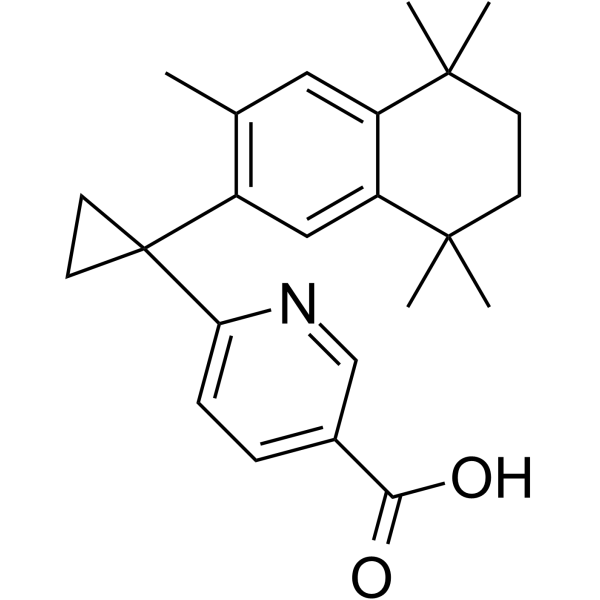
-
- HY-13717
-
|
IRX4204; NRX194204; VTP 194204
|
RAR/RXR
Apoptosis
|
Inflammation/Immunology
Cancer
|
|
AGN194204 (IRX4204) is an orally active and selective RXR agonist with Kd values 0.4 nM, 3.6 nM and 3.8 nM and EC50s of 0.2 nM, 0.8 nM and 0.08 nM for RXRα, RXRβ and RXRγ, respectively. AGN194204 is inactive against RAR. AGN194204 has anti-inflammatory and anticarcinogenic actions .
|
-
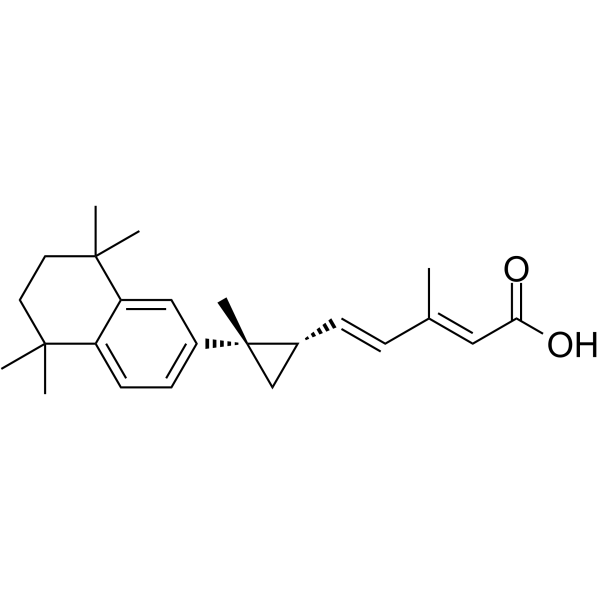
-
- HY-14171
-
|
LGD1069
|
RAR/RXR
Autophagy
|
Cancer
|
|
Bexarotene (LGD1069) is a high-affinity and selective retinoid X receptors (RXR) agonist with EC50s of 33, 24, 25 nM for RXRα, RXRβ, and RXRγ, respectively. Bexarotene shows limited affinity for RAR receptors (EC50 >10000 nM) . Bexarotene can be used for the research of cutaneous T-cell lymphoma.
|
-
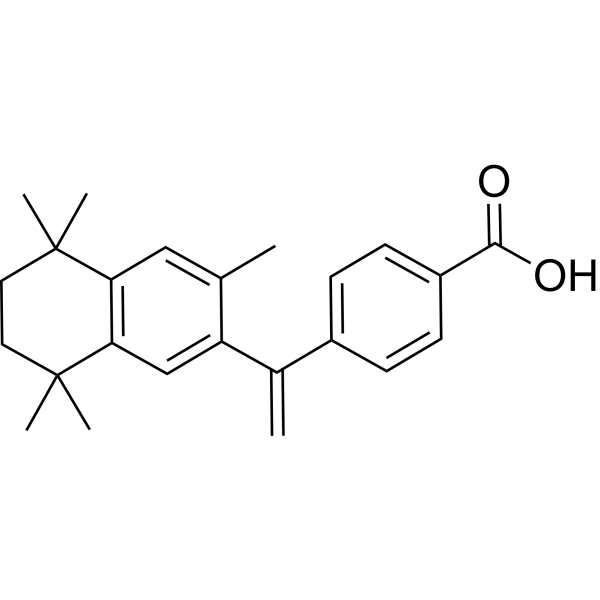
-
- HY-P1731
-
|
LY3298176
|
GLP Receptor
|
Neurological Disease
Metabolic Disease
Cancer
|
|
Tirzepatide (LY3298176) is a glucose-dependent insulin nutritive polypeptide (GIP) and glucagon-like peptide-1 (GLP-1) receptor dual agonist. Tirzepatide has neuroprotective effects and can be used in the study of type 2 diabetes, diabetes-related neuropathy and obesity .
|
-
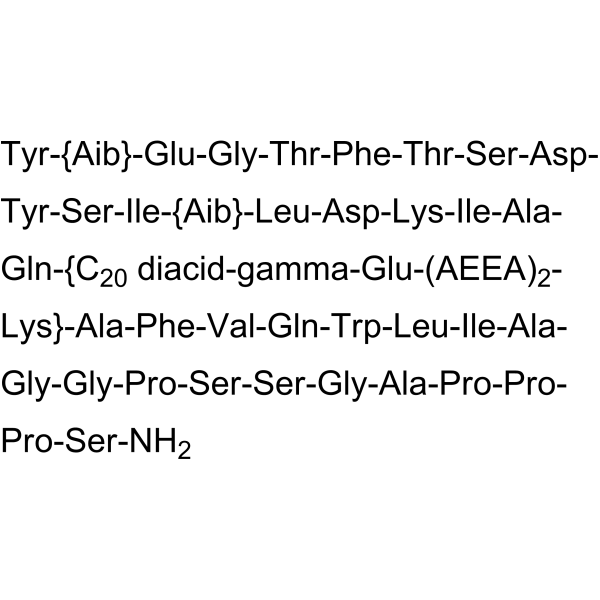
-
- HY-P1731B
-
|
LY3298176 hydrochloride
|
GLP Receptor
|
Neurological Disease
Metabolic Disease
Cancer
|
|
Tirzepatide hydrochloride (LY3298176 hydrochloride) is a glucose-dependent insulin nutritive polypeptide (GIP) and glucagon-like peptide-1 (GLP-1) receptor dual agonist. Tirzepatide hydrochloride has neuroprotective effects and can be used in the study of type 2 diabetes, diabetes-related neuropathy and obesity .
|
-
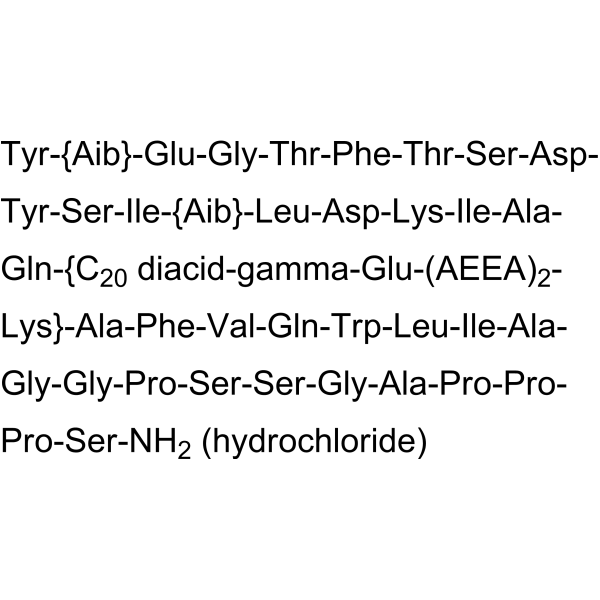
-
- HY-P1731A
-
|
LY3298176 TFA
|
GLP Receptor
|
Neurological Disease
Metabolic Disease
Cancer
|
|
Tirzepatide TFA (LY3298176 hydrochloride) is a glucose-dependent insulin nutritive polypeptide (GIP) and glucagon-like peptide-1 (GLP-1) receptor dual agonist. Tirzepatide TFA has neuroprotective effects and can be used in the study of type 2 diabetes, diabetes-related neuropathy and obesity .
|
-
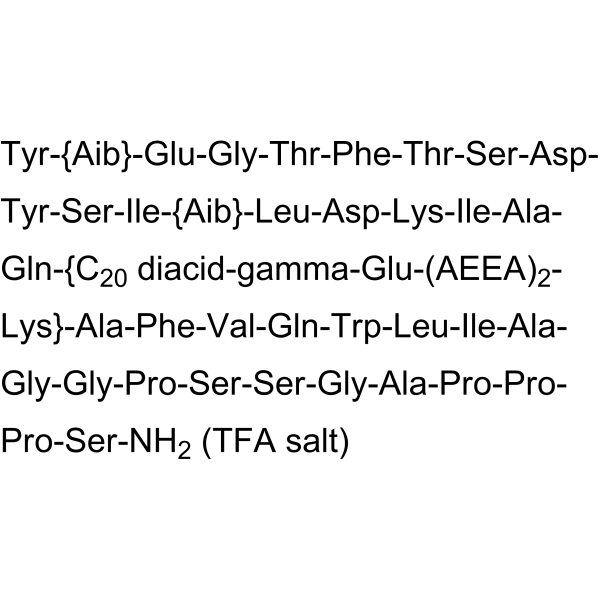
| Cat. No. |
Product Name |
Target |
Research Area |
-
- HY-P1731
-
|
LY3298176
|
GLP Receptor
|
Neurological Disease
Metabolic Disease
Cancer
|
|
Tirzepatide (LY3298176) is a glucose-dependent insulin nutritive polypeptide (GIP) and glucagon-like peptide-1 (GLP-1) receptor dual agonist. Tirzepatide has neuroprotective effects and can be used in the study of type 2 diabetes, diabetes-related neuropathy and obesity .
|
-
- HY-P1731B
-
|
LY3298176 hydrochloride
|
GLP Receptor
|
Neurological Disease
Metabolic Disease
Cancer
|
|
Tirzepatide hydrochloride (LY3298176 hydrochloride) is a glucose-dependent insulin nutritive polypeptide (GIP) and glucagon-like peptide-1 (GLP-1) receptor dual agonist. Tirzepatide hydrochloride has neuroprotective effects and can be used in the study of type 2 diabetes, diabetes-related neuropathy and obesity .
|
-
- HY-P1731A
-
|
LY3298176 TFA
|
GLP Receptor
|
Neurological Disease
Metabolic Disease
Cancer
|
|
Tirzepatide TFA (LY3298176 hydrochloride) is a glucose-dependent insulin nutritive polypeptide (GIP) and glucagon-like peptide-1 (GLP-1) receptor dual agonist. Tirzepatide TFA has neuroprotective effects and can be used in the study of type 2 diabetes, diabetes-related neuropathy and obesity .
|
| Cat. No. |
Product Name |
Category |
Target |
Chemical Structure |
| Cat. No. |
Product Name |
Chemical Structure |
-
- HY-14649S4
-
|
|
|
Retinoic acid-d5 is the the deuterium labeled Retinoic acid (HY-14649). Retinoic acid is a metabolite of vitamin A that plays important roles in cell growth, differentiation, and organogenesis. Retinoic acid is a natural agonist of RAR nuclear receptors, with IC50s of 14 nM for RARα/β/γ. Retinoic acid bind to PPARβ/δ with Kd of 17 nM. Retinoic acid acts as an inhibitor of transcription factor Nrf2 through activation of retinoic acid receptor alpha .
|
-

-
- HY-U00449S
-
|
|
|
AGN 193109-d7 is the deuterium labeled AGN 193109. AGN 193109 is a retinoid analog, and acts as a specific and highly effective antagonist of retinoic acid receptors (RARs), with Kds of 2 nM, 2 nM, and 3 nM for RARα, RARβ, and RARγ, respectively.
|
-

-
- HY-100532S
-
|
|
|
CD437- 13C6 is the 13C- and deuterium labeled CD437. CD437 is a selective Retinoic Acid Receptor γ (RARγ) agonist.
|
-

-
- HY-B0091S
-
|
|
|
Adapalene-d3 is the deuterium labeled Adapalene. Adapalene (CD271), a third-generation synthetic retinoid, is widely used for the research of acne. Adapalene is a potent RAR agonist, with AC50s of 2.3 nM, 9.3 nM, and 22 nM for RARβ, RARγ, RARα, respectively. Adapalene also inhibits the enzymatic activity of GOT1 in a non-competitive manner. Adapalene exhibits anti-tumor activity[1][2][3].
|
-

-
- HY-14649S2
-
|
|
|
11-cis-Retinoic Acid-d5 is the deuterium labeled Retinoic acid. Retinoic acid is a metabolite of vitamin A that plays important roles in cell growth, differentiation, and organogenesis. Retinoic acid is a natural agonist of RAR nuclear receptors, with IC50s of 14 nM for RARα/β/γ. Retinoic acid bind to PPARβ/δ with Kd of 17 nM. Retinoic acid acts as an inhibitor of transcription factor Nrf2 through activation of retinoic acid receptor alpha[1][2].
|
-

-
- HY-14649S3
-
|
|
|
Retinoic acid-d6 is the deuterium labeled Retinoic acid[1]. Retinoic acid is a metabolite of vitamin A that plays important roles in cell growth, differentiation, and organogenesis. Retinoic acid is a natural agonist of RAR nuclear receptors, with IC50s of 14 nM for RARα/β/γ. Retinoic acid bind to PPARβ/δ with Kd of 17 nM. Retinoic acid acts as an inhibitor of transcription factor Nrf2 through activation of retinoic acid receptor alpha[2][3][4][5][6][7].
|
-

| Cat. No. |
Product Name |
Application |
Reactivity |
-
- HY-P82115
-
|
NR1B3; RAR gamma; RARC; RARg
|
WB, ICC/IF
|
Human, Rat |
Your information is safe with us. * Required Fields.
Inquiry Information
- Product Name:
- Cat. No.:
- Quantity:
- MCE Japan Authorized Agent:













































